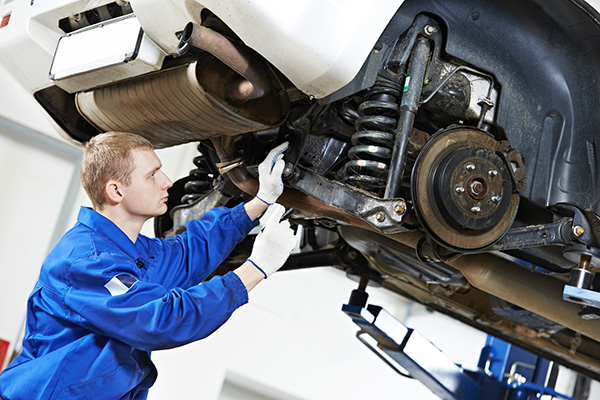
If you’re noticing your car doesn’t ride as comfortably as it used to, or maybe it's making a few odd noises on bumpy roads, it could be an issue with the suspension. The suspension system is affecting everything from how your vehicle handles to how comfortable your ride is. But as resilient as modern suspensions are, they aren’t immune to wear and tear. So, what are drivers' common suspension problems, and what can be done to address them?
The Importance of a Car's Suspension System
Your car’s suspension isn’t just about keeping the ride comfortable; it’s also key to safety and control. It manages the friction between your tires and the road, helping maintain stability even when the terrain isn’t ideal. When the suspension is in top shape, your car absorbs the shocks from the road, keeps you safe, and lets you handle turns and stops effectively. But as time goes on, components like shock absorbers, struts, and bushings can wear out, leading to noticeable changes in how the car drives. Recognizing the signs early can help you avoid costly repairs and keep your vehicle safe on the road.
Bumpy Rides and Worn-Out Shock Absorbers
Shock absorbers are essential to keeping the car steady on uneven surfaces. They absorb the jolts from the road, ensuring the wheels maintain contact and providing a stable, controlled ride. However, as they wear out, you may notice that every little bump feels exaggerated. If the ride becomes noticeably rougher or you feel the car bouncing more than usual, worn-out shock absorbers are likely to blame. When shocks or struts are no longer effective, they not only compromise comfort but also make it more difficult to control the vehicle, especially when stopping suddenly or driving on wet roads.
Misalignment and Uneven Tire Wear
Suspension issues can also show up as alignment problems. If your car seems to drift to one side, even when you’re driving on a straight road, it’s often a sign that the alignment is off. Misalignment is frequently caused by worn suspension components, including bushings and control arms, which hold the system together and manage how the wheels move. Uneven tire wear can also be an indicator of alignment issues. Tires should ideally wear down evenly, but certain areas wear faster than others when the suspension isn’t properly aligned. This affects both the lifespan of the tires and your safety, as it impacts traction on the road.
Noisy Suspension
If you hear strange noises every time you hit a bump or turn a corner, your suspension could be the source of the problem. Clunking, squeaking, or rattling noises often come from worn or loose components in the suspension system, such as bushings, joints, or control arms. Bushings, which act as cushions for various suspension parts, tend to wear out over time, especially if exposed to harsh weather conditions. As bushings degrade, the metal parts of the suspension begin to make contact, leading to noises and a less comfortable ride. Addressing these noises early on is important, as continued driving with loose suspension parts can lead to more severe damage.
Steering Problems and Worn Ball Joints
Steering issues often arise from problems with the suspension system. Ball joints, which connect the wheels to the suspension, allow for a range of movement in the steering. As these joints wear down, you may notice more play or looseness in the steering wheel, making it harder to control the car precisely. This is particularly noticeable when taking turns or driving over bumps. Worn ball joints can also lead to “steering drift,” where the vehicle doesn’t stay on course without constant adjustment. Steering issues should never be ignored, as they can severely impact your ability to control the vehicle in unexpected situations.
Sagging and Broken Springs
Springs play a crucial role in keeping your vehicle at the correct height and supporting the weight of the car. Over time, however, these springs can sag or even break, causing one side of the car to sit lower than the other. If your vehicle appears unbalanced or you notice a drop on one side, a damaged spring might be the culprit. Driving with a broken spring can be dangerous, as it affects stability, especially when braking or taking turns. Replacing the springs not only restores the vehicle’s balance but also ensures that other components in the suspension system are not overloaded or strained.
Why Addressing Suspension Issues Is Important
Driving with suspension problems isn’t just uncomfortable; it’s unsafe. An impaired suspension affects your ability to steer, stop, and handle your vehicle in emergency situations. Beyond safety, unresolved suspension problems can lead to more extensive repairs over time. For example, driving with poor alignment or worn shocks can cause premature tire wear, ultimately costing you more in replacement tires. The added strain on other parts of the car can also lead to further issues down the line as interconnected components start to wear down faster than expected.
A well-maintained suspension system extends the lifespan of your tires, protects other vehicle components, and ensures that your car handles predictably and safely. If you notice any of these signs—whether it’s rough rides, alignment issues, or strange noises—consider having your suspension system inspected and serviced.
Is your car’s suspension feeling off? Book a comprehensive inspection at Lorentz Automotive and let our team help restore your vehicle’s comfort and control.